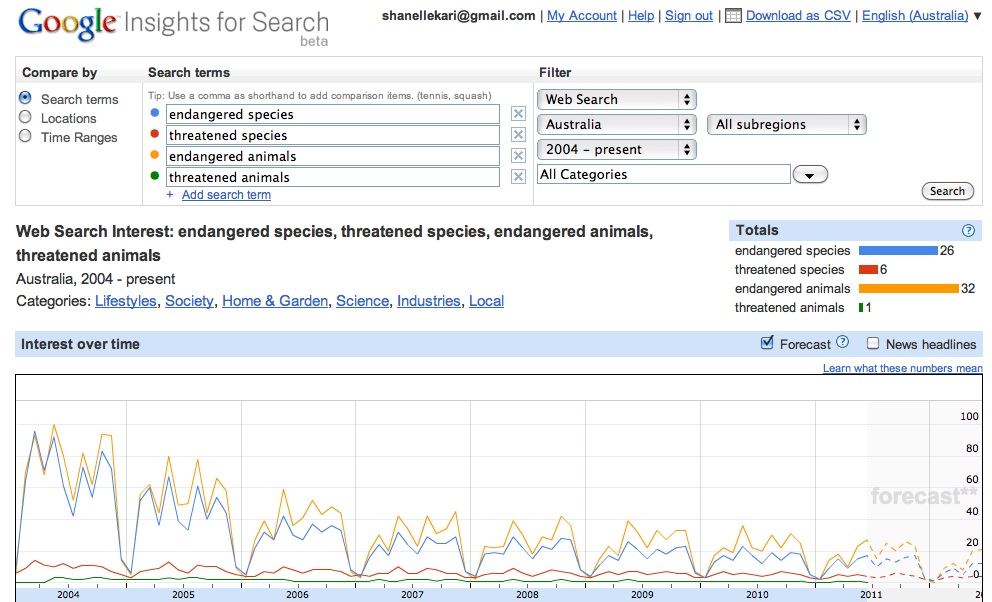I haven’t had a lot of time to write in the last week as I’ve been busy preparing my second SEO workshop for one of my clients, the Nature Conservation Trust, as well as getting closer and closer to launching the new WWF-Australia website. It’s all coming along nicely thanks to the ability to use Google Insights for keyword research – if you haven’t heard of Google Insights or used it, try it today.
Google Insights allows you to sift through your list of important keywords that you have selected as important to your website, product or brand, and identify the keywords with the highest traffic volume. There is no guess work, the data is there in black and white and in graph form!
Remember, search is about the user, not the brand. Businesses and organisations often make the mistake of writing their website from their own point of view, to tell the story they want their customers, clients, audience to hear. This is wrong. Good marketing and good website content is about choosing your target market and understanding what your audience wants and needs and delivering that to them in a way that makes sense to them.
Good website content also makes an effort to prepare content in a way that will speak to the target audience(s) no-matter where they are in their consideration cycle. If they’re at the beginning of the consideration cycle and are just starting to investigate and research, they require very different information than if they’ve made a decision and are now shopping to compare prices and value.
Google Insights helps you break through the many unknowns and focus your efforts only on the best keywords, the ones that match your product or brand but also meet your audience’s needs – the keywords with the largest search volume. For example, at WWF our core business is the conservation of threatened species and their habitats. WWF are a science based organisation who prides themselves on their scientific integrity and accuracy. Scientifically, the term for an animal or species that is under threat of extinction is “threatened” and in fact there are several levels of threatened including vulnerable, near threatened, endangered, critically threatened and extinct. But the average user searching for threatened species (animals and plants) tend to use the term endangered far more often. So we at WWF have a problem.
 WWF are a science based organisation that needs to be seen to always be scientifically accurate but I, as a marketer and search engine optimisation specialist, is advising that we need to use the word endangered in our website content more often so as to capture the large volumes of people that are looking for our threatened species information. I argue that we can educate users once they arrive on the website, but if we do not use the term endangered, we are missing out on thousands of potential new users and possible donors each month. And that’s just the scientific terms. There are also the plain english language terms that we need to consider, such as animals instead of species. You will see what I mean from the Google Insights screenshot below. These are the type of challenges you will come across when building your SEO and content strategy.
WWF are a science based organisation that needs to be seen to always be scientifically accurate but I, as a marketer and search engine optimisation specialist, is advising that we need to use the word endangered in our website content more often so as to capture the large volumes of people that are looking for our threatened species information. I argue that we can educate users once they arrive on the website, but if we do not use the term endangered, we are missing out on thousands of potential new users and possible donors each month. And that’s just the scientific terms. There are also the plain english language terms that we need to consider, such as animals instead of species. You will see what I mean from the Google Insights screenshot below. These are the type of challenges you will come across when building your SEO and content strategy.
Google Insights is a free tool that is available to anyone who has an internet connection. It takes the guess work out of your website content and SEO strategies. It allows you to identify gaps in the market as well as gaps in your own website content.
If you do not have the budget to invest in online research tools such as Nielsen Online or Hitwise Market Intelligence, Google Insights and Google Trends offer a wealth of information to help you make educated decisions about the search keywords you should be targeting.
SEO isn’t rocket science, but it is more than just keywords. It’s about anchor text and linking, it’s about content silos and information architecture and of course your html and xml site maps.
Keep reading and learning and let me know if you have any questions.

Trackbacks/Pingbacks